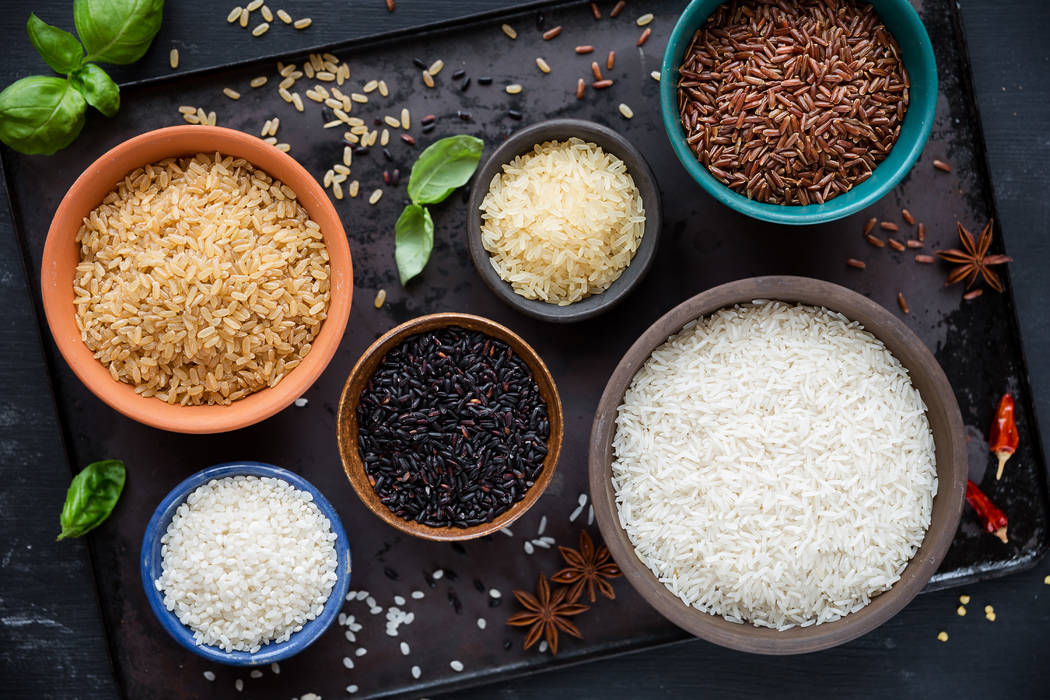Las Vegas chefs are finding new, creative ways to use rice

With more than 40,000 varieties being cultivated around the world, rice offers much to explore. And Las Vegas chefs are always finding new ways to use it.
Oscar Amador, chef at Edo Gastro Tapas & Wine, was raised in Barcelona, Spain. He said he favors three varieties of rice: bomba, calasparra and senia. For a Spanish chef, he said, bomba “is like the king of rice. It’s short grain. It’s the perfect rice to cook the paella. It takes all the aroma from the broth you use.”
Calasparra, he said, is medium grain and used in meloso, which he said is sort of the Spanish version of risotto. And senia, which has a short grain, is used in “soupy rices” native to Barcelona.
Terence Fong, who has Zenshin at the South Point and Island Sushi & Grill on Eastern Avenue, has been a chef in Las Vegas for more than 40 years. Fong has cooked with numerous varieties and thinks most people — including chefs — are unfamiliar with many of them.
“Only certain chefs brought up in the culture are using” the less-common types, said Fong, a native of Hawaii.
“There are so many applications that rice can be used for, not just steaming and eating as is,” said fellow Hawaii native Ken Lum, chef de cuisine at Emeril’s New Orleans Fish House at MGM Grand. “You can grind it up and use it as a starch thickener. Rice flour — one of my favorite desserts is mochi,” an unbaked Japanese pastry made of pounded rice that’s used in various applications, such as wrapping it around balls of ice cream.
Alan Ji, executive chef of Mott 32 at The Venetian and a native of Shanghai, said in China alone, the rice in different regions of the country possess different qualities. And various types lend themselves to a variety of uses.
Besides brown, which is white rice that hasn’t been milled and polished, rice comes in naturally occurring colors such as black (which can look purple when cooked), red and gold.
Lum said rice was a daily thing when he was growing up, specifically Calrose, a medium-grain white credited with launching the California rice industry. But because of his restaurant’s Southern orientation, he’s currently partial to Carolina Gold from Anson Mills.
“They grow the heirloom varieties,” he said. “It’s an awesome product — almost like a flaky rice. It’s not so much aromatic but has a light, popcorny manner.”
But he also sometimes uses Bhutanese red and Thai forbidden rice, which is black.
“We like to mix it together,” he said, “because they have different flavor profiles. Plus, it makes a great presentation.”
In Hawaii, he said, he used the red and black in foie gras fried rice; “The fat element comes out of the foie gras and flavors the rice.”
Fong said the ever-present place of rice in life made cooks more creative.
“If you’ve made a mistake, you do not throw anything away,” he said. “If you overcook it by accident, use it for dessert, or make rice cakes. Saute a rice cake and use it as an entree; incorporate some Parmesan cheese, mushrooms, sun-dried tomatoes.
“Old school, if you burned your pot, you never threw away the bottom of your rice. People used it like the Japanese do okoge rice. I do it on purpose. I put rice on both sides of my nori and then I shallow pan-fry it crispy, turn it over again, and I cut it up bite-sized and I put like spicy tuna on it and unagi sauce. It has texture and a little nutty taste, dark brown to almost black at the edges.”
The chefs also go old school when cooking rice, using the first-knuckle-on-the-index-finger method to test water depth. Ji said to wash the rice first and then wait an hour before cooking. Lum said after cooking it, let it sit, covered, for 20 minutes before serving. Fong said he uses 3 parts rice to 2 3/4 parts water for sushi rice, 1 part rice to 1 1/4 parts chicken stock for red or black.
You may want to just follow package directions.
“In our household, we never had a rice cooker,” Lum said.
Agreed Ji: “In China a long time ago, they didn’t have electric rice cookers.”
And here’s a final bit of trivia: Wild rice isn’t rice, but comes from four species of grasses. While it’s cultivated, some of it still is harvested wild, the grasses bent over canoes and flailed to release the grain.
Contact Heidi Knapp Rinella at Hrinella@reviewjournal.com or 702-383-0474. Follow @HKRinella on Twitter.